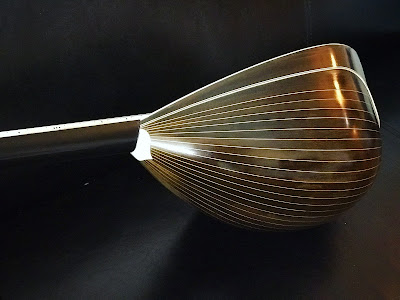The unique sound of an old Zozef
Secrets under the soundboard !
The mid to late 1950s four course Zozef Terzivasian bouzouki has finally spoken. The long anticipation for the completion of its restoration , and the excitement to hear it’s unique voice has paid off.
Since it was built originally as a three course bouzouki, with a small three-course-bowl, and a Neapolitan mandolin bend on the soundboard, there was already a good start for an anticipated unique sound quality.
But this little gem had more secrets to reveal!
Zozef Terzivasian had converted his original construction (of a three course bouzouki), to a four course bouzouki , some years later, following the original owner’s request.
The luthier had added approx 0.5 cm to each side of the neck and the fretboard, keeping all the original three course elements intact.
Surprisingly the original construction of the neck was made by solid piece of linden tree wood, without any laminations.
As a result, the neck of this bouzouki instrument has almost “ zero weight” , and the sound transmission from the bowl to the neck is superb !
But there is one more secret which was kept under the soundboard and had intrigued the curiosity of Chris Pantazelos ( the master luthier who made the restoration ) and mine !
This bouzouki has a very unique set up of the soundboard’s braces ! ( very similar to the Roman mandolin braces of the 19 th century )
Accordingly to the author, musician, and researcher Stavros Kourousis, Zozef Terzivasian , during his early years , studied the construction of mandolins made by master luthiers, and he experimented in various set-ups of soundboard and braces, testing the sound quality and the timbre. Accordingly to Stavros, Zozef was also a collector of mandolins!
The braces on this bouzouki are thin on the width, but with a raised height at the ends, following a shallow curvature in the middle , and a “hill shape” raised height at the center.
This unique shape of the braces is more profound on the first brace closer to the bridge, and less profound toward the last brace closer to the sound-hole and the neck !
The braces are also extending outside the width of the soundboard, and they had been anchored perfectly in the sides of the capping strips.
Finally, the last surprise came from the information shared by the creator of the famous musical instrument cases ASMIR, Tasos Smyrloglou.
Accordingly to Tasos the bouzouki kept inside a 1940s Georgiou Smyrloglou ( founder of ASMIR) hard case.
The hard case survived after so many years in a good condition!
Well, someone will ask
- Enough with the surprises… what about the sound of this instrument ?
Ahhhh yes!… the sound !
The bouzouki produces a very unique sound which carries the familiar characteristics of Zozef Terzivasian ‘s bouzouki timbre ( the natural powerful reverb, and the metallic / tzaz-ing ending of the strings )
But this sound timbre is far from the 1960s-1970s four course Zozef ‘s sound . It is much closer to the three course early Zozef sound but with unique sound traces of a four course bouzouki!
The sustain lasts for an extended period of time, creating a powerful metallic timbre.
The natural reverb is so powerful, creating a natural echo which transmits through the whole body of the bouzouki as the player is hitting the strings !
The treble is crisp and clear, the mids create a “grezia “ unique quality , and the bass is clear and powerful
Here are some samples of its unique voice . Raw recording without any audio console, or special microphones, just simply from the voice memo of the cellphone
PS: Due to it’s long trip in an airplane ( with dramatic changes in humidity , temperature and pressure ) it’s sound quality is expected to be improved and clear-up the following weeks. Stay tuned !
Testing sound quality and timbre











Comments
Post a Comment